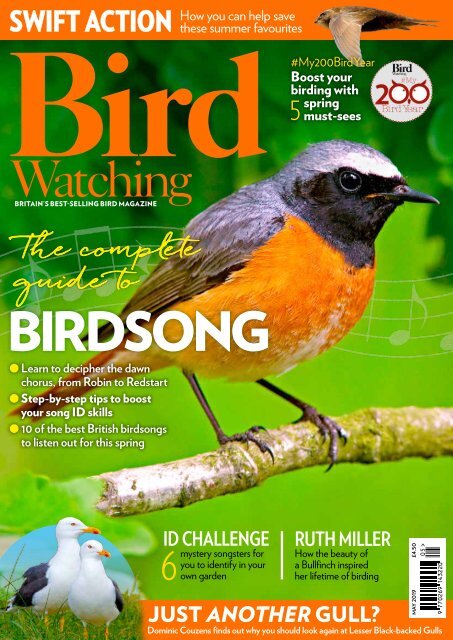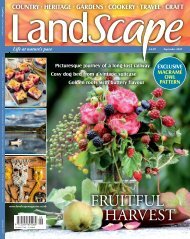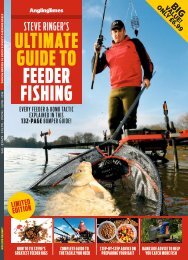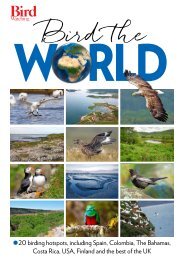BirdWatching-May19
Create successful ePaper yourself
Turn your PDF publications into a flip-book with our unique Google optimized e-Paper software.
swift action<br />
How you can help save<br />
these summer favourites<br />
#My200BirdYear<br />
Boost your<br />
birding with<br />
spring<br />
must-sees<br />
5<br />
Britain’s best-selling bird magazine<br />
birdsong<br />
l Learn to decipher the dawn<br />
chorus, from Robin to Redstart<br />
l Step-by-step tips to boost<br />
your song ID skills<br />
l 10 of the best British birdsongs<br />
to listen out for this spring<br />
ID CHALLENGE<br />
mystery songsters for<br />
you to identify in your<br />
own garden<br />
6<br />
RUTH MILLER<br />
How the beauty of<br />
a Bullfinch inspired<br />
her lifetime of birding<br />
just another gull?<br />
Dominic Couzens finds out why you should look again at Lesser Black-backed Gulls<br />
MAY 2019 £4.50
may<br />
Contents<br />
12<br />
6<br />
news & comment<br />
14<br />
16<br />
17<br />
Weedon’s World<br />
Share Mike’s delight in seeing a<br />
Kittiwake in an unusual location<br />
NewsWire<br />
Fund-raising appeal launched for<br />
bird observatory ravaged by fire<br />
Grumpy Old Birder<br />
How do you fare when it comes to<br />
digiscoping when out birding?<br />
features<br />
22<br />
18<br />
44<br />
in the field<br />
86<br />
bird the world<br />
70<br />
74<br />
Garden birding<br />
Red Kites soaring above her garden<br />
bring nothing but joy to Clare<br />
Your View<br />
The best of the month’s readers’<br />
photos, letters and queries<br />
on the cover<br />
21 #My200BirdYear - boost<br />
your spring birding<br />
22 Complete guide to birdsong<br />
35 The Swift - how you can help<br />
these summer favourites<br />
44 Ruth Miller - the beauty of<br />
the Bullfinch<br />
47 ID challenge - identify<br />
six great singers!<br />
66 Dominic Couzens on<br />
Lesser Black-backed Gull<br />
21<br />
22<br />
32<br />
35<br />
40<br />
44<br />
66<br />
Five spring must-sees<br />
Add new species to your<br />
#My200BirdYear list<br />
Complete guide to<br />
learning birdsong<br />
Follow our top tips and advice on<br />
learning how to master the art of<br />
identifying birdsong<br />
Birding by sound<br />
Tips on identifying birds by their<br />
songs and calls<br />
Swift action<br />
How the city of Oxford is hoping to<br />
reverse the fortunes of Swifts<br />
Home help<br />
And learn how you can help our<br />
Swifts at home<br />
A lifetime’s passion<br />
Ruth Miller recalls the moment she<br />
first fell in love with birding<br />
Lesser Black-backed Gull<br />
Dominic Couzens on why there’s<br />
more to this seaside speciality than<br />
meets the eye<br />
66<br />
6<br />
12<br />
47<br />
53<br />
Your Birding Month<br />
Birds to find this month include<br />
Quail, Turtle Dove and Nightjar<br />
Beyond Birdwatching<br />
The types of insect to find on<br />
a warm, spring day<br />
ID Challenge<br />
Celebrate the dawn chorus by<br />
identifying six great singers<br />
Go Birding<br />
Ten great sites to head to for<br />
some brilliant birding<br />
subscribe now<br />
and pay<br />
£2.80*<br />
a month<br />
– see p18<br />
*when you choose the digital option<br />
and pay by direct debit<br />
79<br />
86<br />
89<br />
Birding Italy<br />
What to expect from a<br />
birdwatching trip to the lovely<br />
regions of Tuscany and Umbria<br />
Birding Orkney<br />
David Lindo on what he calls<br />
“an underestimated urban<br />
birder’s paradise”<br />
Travel round-up<br />
It’s exotic birds (and mammals)<br />
galore on this Bird Watching<br />
Reader Holiday to Uganda!<br />
tutorial<br />
114<br />
99<br />
102<br />
94<br />
95<br />
Back Chat<br />
Teenage birder Mya-Rose Craig<br />
answers our questions<br />
bird sightings<br />
Rarity Round-up<br />
The best rare birds seen in the UK<br />
and Ireland during February<br />
UK Bird Sightings<br />
A round-up of birds seen in your<br />
area during February<br />
gear & reviews<br />
90 Camera School<br />
92 Gear<br />
How to achieve great results in<br />
David Chandler tries out a<br />
bird photography<br />
variety of clothing, from<br />
trousers to a hat<br />
Books<br />
The best of the latest releases,<br />
including: Endangered<br />
WishList<br />
Birding-related goodies this month<br />
include binoculars and jackets<br />
4 May 2019 birdwatching.co.uk 5
CONSERVATION swift boxes<br />
NOW!<br />
As you have read over the previous pages, our<br />
Swifts are in trouble... here’s how you can help<br />
words: JAMIE WYVER<br />
Alan Williams/Alamy*<br />
Swifts spend the winter months<br />
many thousands of miles south<br />
of the UK, sweeping over<br />
sub-Saharan landscapes.<br />
So, now is the perfect time of year<br />
to put up a nest site for these avian<br />
adventurers – ensuring they have<br />
somewhere to nest when they return from<br />
their epic journeys.<br />
A life on the wing<br />
Screaming parties of Swifts are a familiar<br />
and welcome sight on warm summer<br />
evenings when you will often catch a<br />
glimpse of their aerial acrobatics.<br />
They are at ease in the sky – feeding,<br />
drinking, mating and even sleeping on the<br />
wing. But they’re in trouble. Swift numbers<br />
dropped by more than 50% in the last<br />
20 years. The reasons behind the decline<br />
are not clear, but we know that Swifts are<br />
losing their precious nest sites. These birds<br />
rely on nooks and crannies in our homes<br />
and other buildings to make their nests.<br />
New builds simply don’t contain the cavities<br />
that swifts need and when older buildings<br />
are renovated the gaps that swifts need<br />
are lost.<br />
Let’s do all we can to ensure<br />
they remain in our skies for many<br />
generations to come<br />
Swifts in a nestbox<br />
Nick Upton/Alamy<br />
How you can help<br />
Fortunately, specially-designed<br />
artificial nest sites for Swifts<br />
are available, providing these<br />
birds with places to nest in new<br />
and old properties alike. If<br />
you’re interested in giving these<br />
birds a home where you live,<br />
work or study, take a look at<br />
the following options:<br />
1Install a ‘Swift brick’ – a simple<br />
solution for new builds or<br />
renovation projects. They fit<br />
neatly in the space that a normal<br />
brick would occupy in a wall and<br />
provide the birds with a cavity in<br />
which to nest. Swift bricks are<br />
available online, and the RSPB<br />
offers a free impartial guide to nest<br />
bricks, available here:<br />
http://bit.ly/2SP8M3p<br />
3If you’re feeling handy, make<br />
your own Swift box. DIY box<br />
designs are available from<br />
Swift Conservation:<br />
http://bit.ly/2UtDgcY<br />
and Action for Swifts:<br />
http://bit.ly/2C9TZe5<br />
Eyes on the skies<br />
In order to protect existing Swift nest<br />
sites, we need to know where they<br />
are. The RSPB Swift Survey is<br />
building up a map of Swift nest sites<br />
and screaming parties across the<br />
country. Visit:<br />
swiftsurvey.org/rspb/home/index<br />
to submit your sightings. Swifts<br />
epitomise summer. Let’s do all we<br />
can to ensure they remain in our<br />
skies for many generations to come.<br />
2Put up a Swift nestbox -<br />
these are designed to be<br />
fitted externally, sitting<br />
tightly under the eaves. Boxes<br />
are available from:<br />
shopping.rspb.org.uk/swiftbox<br />
BW<br />
40 May 2019 birdwatching.co.uk 41
DOMINIC<br />
COUZENS<br />
ON THE...<br />
Lesser Black-backed Gull<br />
This seaside species is a great example of<br />
never judging a bird by its name – there’s a<br />
lot more to it than you might think...<br />
species factfile<br />
lesser blackbacked<br />
gull<br />
Scientific name:<br />
Larus fuscus<br />
Length: 52-64cm<br />
Wingspan: 135-150cm<br />
UK numbers: 110,000 breeding pairs<br />
/ 130,000 wintering birds<br />
Habitat: Coast<br />
Diet: Scavenges a wide range<br />
of food<br />
FLPA/Alamy*<br />
I<br />
give you the Lesser Black-backed<br />
Gull, the British bird with the most<br />
off-putting name. Lesser – that can<br />
mean inferior. Black-back is a clunky<br />
rhyme. And talking of rhymes, gull<br />
rhymes with dull. In most people’s eyes,<br />
that’s exactly what gulls are – boring.<br />
They are worse than that. Gulls are<br />
noisy and lacking in airs and graces.<br />
And for birders, gulls are a nightmare<br />
to identify, which is the worst sin of all.<br />
Did you think twice before beginning to<br />
read this article?<br />
The Lesser Black-backed Gull also lives<br />
and dies by comparison. Where there is<br />
a ‘Lesser’, there must be a ‘Greater’. The<br />
Great Black-backed Gull is the bird closest<br />
to a Hollywood heavy in a crime movie;<br />
the species most likely to have tattooed<br />
forearms. It has a proper identity as the<br />
largest gull in the world. It swallows<br />
Puffins and does other cool but cruel<br />
stuff. The Lesser does none of this. It is<br />
more closely related to the Herring Gull,<br />
another bird with a clear role as the<br />
clanging atmosphere-creator of seaside<br />
towns, and the bird that shocks Daily<br />
Mail readers by stealing chips from<br />
holidaymakers, without asking. In<br />
comparison with these strong characters,<br />
is there something special to put forward<br />
for the Lesser? There is.<br />
Let’s hear the drum roll for… the bird<br />
with the world’s most leisurely migratory<br />
journey. Is that accolade enough? Some<br />
scientists tracked Lesser Black-backs on<br />
their autumn migration (from the<br />
Netherlands to Britain, to southern Europe<br />
or to north-west Africa), and found that<br />
they only travelled, on average, 27 miles<br />
a day. That, for any bird, is fantastically<br />
slow – a Swallow exceeds that in an hour.<br />
They could almost have walked. The<br />
researchers found that the furthest any<br />
individual gull moved on migration was<br />
110 miles in a single day, which many<br />
bird species exceed while just feeding<br />
their young in a 24-hour period. This,<br />
however, is for travelling a median overall<br />
distance of 745 miles (adults).<br />
Easily distracted<br />
The reason for this extraordinary lack<br />
of urgency would appear to be that Lesser<br />
Black-backed Gulls are easily distracted<br />
– so much so that you can imagine them<br />
setting out with the best of migratory<br />
intentions in the morning, only to come<br />
across a tempting food supply and<br />
thinking “Well, this is great, I can always<br />
fly tomorrow.” Their recorded journeys<br />
were haphazard, almost serendipitous,<br />
with frequent changes of direction. If you<br />
think about it, to move in a chilled way<br />
like this is a smart migration.<br />
Speed isn’t always necessary.<br />
The very fact that Lesser Black-backed<br />
Gulls make long-distance movements<br />
down towards the Iberian Peninsula and<br />
North Africa for the winter (occasionally<br />
even well down the West African coast) is<br />
a defining characteristic not shared by<br />
Herring or Great Black-backed Gulls. The<br />
former do make some movements, but the<br />
numbers are not high. Great Black-backs<br />
come to Britain from further north, but<br />
equally don’t travel in big numbers<br />
much to the south of us. Lessers are thus<br />
list!<br />
Add this bird to your<br />
list !<br />
Add this bird to your<br />
Krystyna Szulecka Photography/Alamy<br />
66 May 2019 birdwatching.co.uk 67
lesser black-backed gull species<br />
where to see<br />
LESSER BLACK-<br />
BACKED GULL<br />
Seen around the UK coastline and<br />
on some inland high moors. The<br />
biggest colony, say the RSPB, is on Walney<br />
Island, Cumbria. In winter, look for them<br />
over fields and at rubbish tips everywhere.<br />
walney<br />
Island,<br />
Cumbria<br />
Adult in winter plumage<br />
in their own class as travellers, with their<br />
relatively light build and long, elegant,<br />
pointed wings. Large numbers are<br />
summer visitors to Britain, of the same<br />
ilk as Swallows and Cuckoos.<br />
However, although many Lesser<br />
Black-backs are bona fide summer<br />
visitors to Britain, arriving in the spring<br />
and leaving in the autumn, not all<br />
individuals are; and, indeed, the picture<br />
has changed enormously since the<br />
mid-point of the 20th Century. Back in<br />
the 1940s, very few Lesser Black-backed<br />
Gulls could ever be found in Britain in<br />
mid-winter – perhaps a few hundred.<br />
But since that time, more and more<br />
individuals have changed their behaviour<br />
and, instead of going south in the<br />
Juvenile still around the nest<br />
autumn, they stay here, instead, now in<br />
their tens of thousands. Although nobody<br />
is entirely sure why this is the case, it is<br />
certainly true that there are more suitable<br />
winter roosting sites, with an enormous<br />
increase in the number of freshwater<br />
gravel pits and reservoirs.<br />
At the same time, landfills, a great<br />
favourite of these arch-scavengers,<br />
proliferated from 1956 onwards, when the<br />
Clean Air Act forbade the burning of much<br />
Ed Brown Wildlife/Alamy<br />
rubbish on tips, leading to the availability<br />
of masses of organic waste – and Lesser<br />
Black-backed Gull heaven. (This itself is<br />
now changing, and many Lesser Blackbacks<br />
are instead feeding over farmland.)<br />
Leavers and Remainers<br />
The Lesser Black-back is now a classic<br />
partial migrant. Among the individuals that<br />
breed at a given British colony, some will<br />
migrate south from Britain in the autumn<br />
and some will stay within our shores.<br />
There are Leaver and Remainer camps<br />
even among gulls, it seems. Some immature<br />
birds in the first year of life actually stay in<br />
their wintering grounds for their first and<br />
even second summer, not bothering to<br />
venture north if they aren’t going to breed.<br />
Even among immature birds, however,<br />
there are some that remain in Britain for<br />
their first winter.<br />
This is not the only big migration change<br />
in the world of the Lesser Black-backed<br />
Gull. Nowadays, it seems, part of the<br />
population from Iceland, that would<br />
normally come south past our shores, has<br />
begun to follow a previously unknown path<br />
to winter on the North American continent.<br />
Once a great rarity across the pond, the<br />
Lesser Black-backed Gull is now found in<br />
Arterra Picture Library/Alamy*<br />
every month of the year in North America,<br />
across the whole swathe of the Eastern<br />
Seaboard, right down to Florida. There are<br />
confident predictions that it will soon breed<br />
(if it hasn’t already) and colonise the east of<br />
that continent. After all, it only colonised<br />
Iceland in the 1920s, so why not cross the<br />
Atlantic as well?<br />
You might think that, in view of this<br />
migratory upheaval, the important things<br />
in the life of the Lesser Black-backed Gull<br />
might instead remain the same – the things<br />
of the home. Yet here, too, great changes<br />
have been afoot, changes that would almost<br />
be unheard of in most species.<br />
When it comes to breeding, the Lesser<br />
Black-backed Gull is traditionally associated<br />
with coastal, flat areas, often with a<br />
reasonable cover of vegetation – it tends to<br />
prefer more plant growth than its colleague<br />
the Herring Gull, for example.<br />
So, there are large colonies on marramgrassy<br />
sand-dunes in north-west England,<br />
and on low islands, and sometimes also on<br />
moorland some distance from the sea.<br />
Studies have shown that Lesser Blackbacked<br />
Gull chicks are better able to<br />
conceal themselves from predators in such<br />
places than are Herring Gulls, which tend<br />
to rely on parents directly protecting their<br />
FLPA/Alamy*<br />
Insert your own phonetic<br />
gull call transcription, here!<br />
young. Herring Gulls spend more time at<br />
the nest during chick-rearing than Lesser<br />
Black-backs. What, then, can we make of<br />
the Lesser Black-backed Gull’s colonisation<br />
of cities, often very far inland (the West<br />
Midlands, for example) by nesting on roofs?<br />
This was another huge change in this<br />
gull’s behaviour that also began in the<br />
1940s, starting slowly but becoming more<br />
significant, and still increasing in some<br />
areas. There isn’t much vegetation on roofs,<br />
but a big plus is that there are few, if any<br />
predators. The gulls are especially fond of<br />
large industrial sites with plenty of roof<br />
area, where they can be colonial.<br />
It is a far cry from a windy moorland,<br />
or a sand-dune, but it clearly works for<br />
this most adaptable of species.<br />
When you look beneath the surface of<br />
an apparently dreary gull’s life, you find<br />
an astonishing capacity to change and<br />
adapt: to change migration distances, to<br />
alter migration routes, to feed on landfills<br />
instead of catching fish from the surface<br />
of the sea, to nest on roofs, to colonise<br />
new countries and even continents.<br />
This isn’t a ‘Lesser’ bird in anything<br />
but name. Instead, it has an identity<br />
carved out of its very aversion to<br />
staying still.<br />
It is, instead, the Dynamic Blackbacked<br />
Gull. BW<br />
look beneath the surface of an apparently<br />
dreary gull’s life, you find an astonishing<br />
capacity to change and adapt<br />
Ashley Cooper pics/Alamy<br />
David Chapman/Alamy<br />
68 May 2019<br />
birdwatching.co.uk 69
interview<br />
A quick chat with…<br />
Mya-Rose Craig,<br />
AKA Birdgirl<br />
illustrations: lauren nicholson<br />
What first sparked your interest<br />
in birdwatching, and when?<br />
I was taken on my first twitch<br />
when I was only nine days old,<br />
to the Isles of Scilly, to see a<br />
Lesser Kestrel. Then, when I<br />
was 18 months old, I was taken<br />
to see the Black Lark on<br />
Anglesey. The bird came close to<br />
my pram and, apparently,<br />
I pointed and shouted “birdie”<br />
with great excitement. That was<br />
my fourth word.<br />
Who was your birdwatching<br />
inspiration or mentor?<br />
I think that when young<br />
children get to about three or<br />
four years old, they realise they<br />
are a separate being from their<br />
parents and can make their own<br />
decisions. That’s when some<br />
birders find their children refuse<br />
to go out birding any more. For<br />
me, the difference was that I had<br />
a much older sister. At that point<br />
in my life, she was 15 years old,<br />
beautiful, cool and obsessed<br />
with birds. If she loved birds, I<br />
was going to love birds.<br />
Bird alone or with a friend?<br />
I bird in my garden, the woods<br />
close to my house and around<br />
my village on my own. I go<br />
dog walking in the woods<br />
with friends, when I get to bird<br />
at the same time. The rest of the<br />
time is with my parents.<br />
Your dream bird to see?<br />
In the UK, a Wallcreeper.<br />
There was one which overwintered<br />
for two years in a<br />
row in Cheddar Gorge in<br />
the 1970s very close to where<br />
I live, which would be amazing.<br />
The bird I would most like<br />
to see in the world is a<br />
Harpy Eagle.<br />
Your favourite birding spot?<br />
In the UK, St Agnes on the Isles<br />
of Scilly for its rarities, scenery,<br />
beaches, friendly pub and just<br />
our family ‘place’. In the world,<br />
definitely Bolivia.<br />
Your classic birder’s lunch,<br />
grabbed from the petrol<br />
station shop?<br />
A large packet of Doritos and<br />
a Divine bar of white chocolate<br />
(neither have palm oil) to go<br />
with my water bottle brought<br />
from home to reduce on plastic.<br />
Blackcap or Garden Warbler?<br />
Blackcap. I have caught a few<br />
in my garden bird ringing.<br />
Favourite bird song or call?<br />
Bittern booming down on the<br />
Somerset Levels.<br />
Birdwatching’s biggest myth or<br />
misconception?<br />
“Teenagers cannot be engaged<br />
with nature”; I hear it all the<br />
time. I have never met a<br />
teenager who hasn’t connected<br />
with nature when it has been<br />
made relevant to them and with<br />
the right role models.<br />
The best bird you’ve seen?<br />
My favourite bird in the world is<br />
a Southern Cassowary which I<br />
saw in Queensland, Australia.<br />
They are 6ft tall, have amazing<br />
colours on them, look like a<br />
dinosaur and have 12cm long,<br />
sharp, nail-like talons that can<br />
kill with one kick.<br />
Identifying gulls – nightmare or<br />
a nice day out?<br />
My Dad and I went to try to see<br />
a very rare Slaty-backed Gull at<br />
a rubbish tip near Rainham<br />
Marshes in 2011. It has to be my<br />
I don’t think there is a bird<br />
that I find annoying, they are<br />
just part of nature<br />
worst birding experience, for<br />
the long walk, the stench and<br />
dipping two days in a row.<br />
Your favourite bird joke?<br />
There’s a bit in the film The<br />
Big Year where Owen Wilson<br />
gives a ‘knowing look’ to Jack<br />
Black about a young loved up<br />
honeymoon couple on the<br />
flight to Attu. The girl clearly<br />
has no clue what she is about<br />
to experience and thinks she<br />
is going to have a romantic<br />
week away. We know it’s<br />
a birding contest.<br />
How do we encourage young<br />
people to watch birds?<br />
In 2016, I organised a<br />
conference, Race Equality in<br />
Nature, to look at the barriers to<br />
Visible Minority Ethnic (VME)<br />
people going out into green<br />
spaces, what can be done to<br />
overcome them and how we can<br />
create VME role models. We<br />
have two more conferences<br />
arranged for June looking at<br />
young VME people. The key<br />
thing is to make it relevant to<br />
them (not you). I also think that<br />
outdoor child-led learning<br />
should be available to every<br />
primary age child, weekly.<br />
Tengmalm’s Owl or Snowy Owl?<br />
Snowy Owl 100%. Only<br />
because I was in Spain seeing<br />
my 5,000th bird species in the<br />
world during half-term (a Rock<br />
Bunting) and missed the<br />
Tengmalm’s Owl.<br />
The one place you’d love to<br />
go birding?<br />
I think the island of New<br />
Guinea, for the birds-of-paradise.<br />
A birding/conservation issue<br />
you feel strongly about?<br />
Equality in nature, conservation and<br />
the environment. Everyone in the<br />
UK has the right to access nature,<br />
like they do education or health.<br />
The bird that annoys you most?<br />
I don’t think there is a bird that I<br />
find annoying, they are just part<br />
of nature.<br />
Bogey bird that still eludes you?<br />
Little Auk.<br />
The bird book you’d never be<br />
without?<br />
In the UK, Collins Bird Guide. In<br />
the world, the field guide to<br />
wherever we are.<br />
Why do you love birdwatching,<br />
in three words?<br />
Sword-billed Hummingbird<br />
Advice for birders taking part in<br />
#My200BirdYear?<br />
I know this is all about seeing<br />
birds locally, which is great for<br />
the environment, so try to go to<br />
one place with a group of<br />
birders, so that you get the most<br />
out of the miles that you drive.<br />
Secondly, have fun!<br />
About Mya-Rose<br />
n The sixteen-year-old birder is<br />
considered the youngest person to<br />
have seen 5,000 bird species<br />
after touring the world.<br />
You can follow her<br />
on Twitter:<br />
@BirdgirlUK<br />
114 May 2019

















